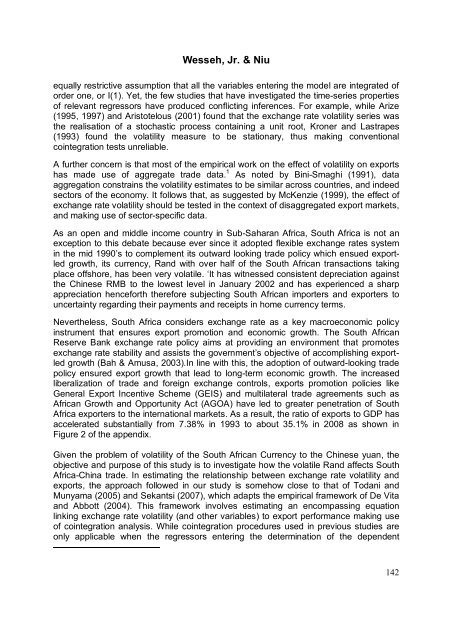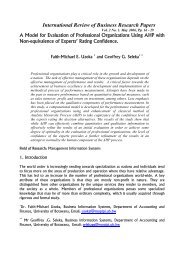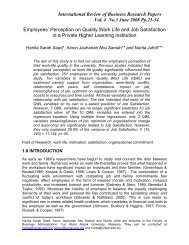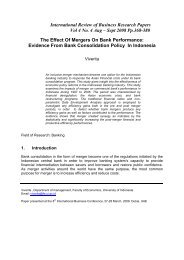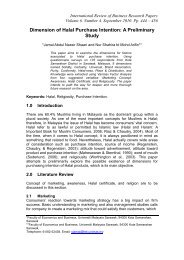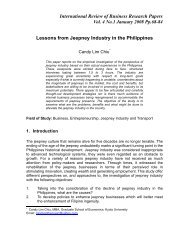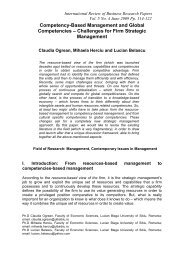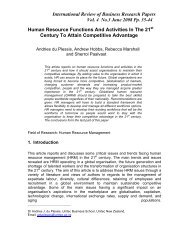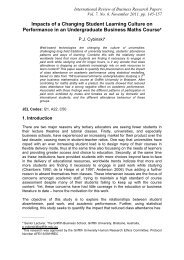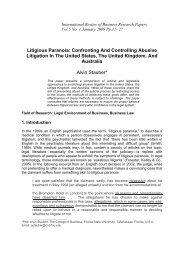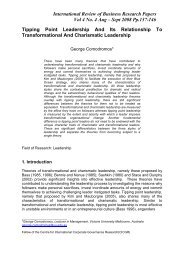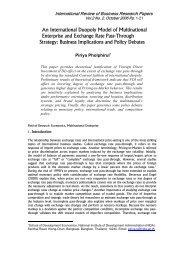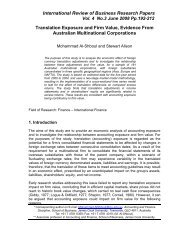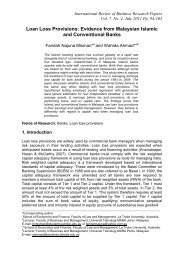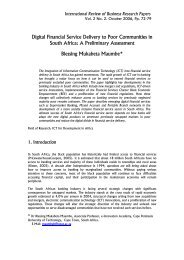Wesseh, Jr. & NiuFor instance, it is comm<strong>on</strong>ly believed that high exchange rate volatility leads to highuncertainty which eventually increases the trading risk. As a matter <str<strong>on</strong>g>of</str<strong>on</strong>g> fact, the literature<str<strong>on</strong>g>of</str<strong>on</strong>g> exchange rate volatility c<strong>on</strong>tains a lot <str<strong>on</strong>g>of</str<strong>on</strong>g> inc<strong>on</strong>sistent theoretical results. Hooper andKohlhagen (1978), Clark (1973), etc. have been cited as theoretical studies withc<strong>on</strong>clusi<strong>on</strong> that volatility decreases trade. <str<strong>on</strong>g>The</str<strong>on</strong>g>se ec<strong>on</strong>omists believe that <strong>on</strong>e reas<strong>on</strong>why this may occur is because <str<strong>on</strong>g>of</str<strong>on</strong>g> imperfect markets situati<strong>on</strong> especially in lessdeveloped countries.C<strong>on</strong>trary to this c<strong>on</strong>clusi<strong>on</strong>, some other theoretical models show that high exchangerate volatility (to the extent that it increases risk) should increase trade. Aziakp<strong>on</strong>o, et al.(2005), believes that this may occur because if exporters are sufficiently risk-averse arise in exchange rate variability leads to an increase in expected marginal utility <str<strong>on</strong>g>of</str<strong>on</strong>g>exports revenue which acts as an incentive to exporters to increase their exports inorder to maximize their revenues. This ambiguity in the theoretical literature causessimilar ambiguity and inc<strong>on</strong>sistencies in the empirical investigati<strong>on</strong> <str<strong>on</strong>g>of</str<strong>on</strong>g> the effects <str<strong>on</strong>g>of</str<strong>on</strong>g>exchange rate volatility <strong>on</strong> exports flowsAccording to De Vita and Abbott (2004), the lack <str<strong>on</strong>g>of</str<strong>on</strong>g> a clear and c<strong>on</strong>sistent pattern <str<strong>on</strong>g>of</str<strong>on</strong>g>results res<strong>on</strong>ates with a number <str<strong>on</strong>g>of</str<strong>on</strong>g> c<strong>on</strong>tentious issues that the empirical literature hasbrought to the fore. <str<strong>on</strong>g>The</str<strong>on</strong>g> first <str<strong>on</strong>g>of</str<strong>on</strong>g> these issues relates to the specificati<strong>on</strong> <str<strong>on</strong>g>of</str<strong>on</strong>g> the exchangerate volatility measure to be adopted and, in particular, over whether such a measureshould be based <strong>on</strong> the nominal or the real exchange rate. Whilst it can be argued thatthe nominal series better captures the volatility driven uncertainty faced by exporters(Bini-Smaghi, 1991), it has also been suggested that because <str<strong>on</strong>g>of</str<strong>on</strong>g> the <str<strong>on</strong>g>of</str<strong>on</strong>g>fsetting role thatmovements in costs and prices play with respect to fluctuati<strong>on</strong>s in the nominalexchange rate, the real exchange rate is the most appropriate measure (Gotur, 1985).A sec<strong>on</strong>d questi<strong>on</strong> c<strong>on</strong>cerns the statistical technique to be used to generate estimates<str<strong>on</strong>g>of</str<strong>on</strong>g> exchange rate volatility. Early studies employed the sample standard deviati<strong>on</strong> <str<strong>on</strong>g>of</str<strong>on</strong>g> theexchange rate (see, for example, Akhtar and Hilt<strong>on</strong>, 1984), a measure subsequentlycriticised because the statistical distributi<strong>on</strong> <str<strong>on</strong>g>of</str<strong>on</strong>g> the exchange rate may be n<strong>on</strong>-normal(Boothe and Glassman, 1987). <str<strong>on</strong>g>The</str<strong>on</strong>g> most comm<strong>on</strong> approach adopted in later work hasinvolved the moving average standard deviati<strong>on</strong> <str<strong>on</strong>g>of</str<strong>on</strong>g> the growth <str<strong>on</strong>g>of</str<strong>on</strong>g> the exchange rate (seeArize et al., 2000) <str<strong>on</strong>g>The</str<strong>on</strong>g> use <str<strong>on</strong>g>of</str<strong>on</strong>g> the moving average formulati<strong>on</strong>, however, has also beenquesti<strong>on</strong>ed (see Arize, 1997) since it is likely to underestimate the effect <str<strong>on</strong>g>of</str<strong>on</strong>g> exchangerate risk, allows for an ad hoc specificati<strong>on</strong> <str<strong>on</strong>g>of</str<strong>on</strong>g> the order <str<strong>on</strong>g>of</str<strong>on</strong>g> the moving average processand, unlike c<strong>on</strong>diti<strong>on</strong>al volatility models such as ARCH (Engle, 1982), is inc<strong>on</strong>sistentwith the rati<strong>on</strong>al behavior <str<strong>on</strong>g>of</str<strong>on</strong>g> ec<strong>on</strong>omic agents. Evidently, despite the abundance <str<strong>on</strong>g>of</str<strong>on</strong>g>research, there is still no c<strong>on</strong>sensus <strong>on</strong> what technique should be used to c<strong>on</strong>struct theoptimal exchange rate volatility measure. Given the many alternatives available, there isclearly a scope for c<strong>on</strong>sidering and comparing multiple definiti<strong>on</strong>s.Another c<strong>on</strong>tentious issue relates to the time series properties <str<strong>on</strong>g>of</str<strong>on</strong>g> the regressorsincluded in the estimated export functi<strong>on</strong>. Most <str<strong>on</strong>g>of</str<strong>on</strong>g> the early studies ignored the need forinvestigating the order <str<strong>on</strong>g>of</str<strong>on</strong>g> integrati<strong>on</strong> <str<strong>on</strong>g>of</str<strong>on</strong>g> relevant variables and used standard OLSregressi<strong>on</strong>s under the err<strong>on</strong>eous assumpti<strong>on</strong> <str<strong>on</strong>g>of</str<strong>on</strong>g> stati<strong>on</strong>arity <str<strong>on</strong>g>of</str<strong>on</strong>g> all the series. In thepresence <str<strong>on</strong>g>of</str<strong>on</strong>g> n<strong>on</strong>stati<strong>on</strong>arity, the Johansen cointegrati<strong>on</strong> procedure (Johansen, 1988,1991) allows testing for the existence <str<strong>on</strong>g>of</str<strong>on</strong>g> a l<strong>on</strong>g-run relati<strong>on</strong>ship but it does so under the141
Wesseh, Jr. & Niuequally restrictive assumpti<strong>on</strong> that all the variables entering the model are integrated <str<strong>on</strong>g>of</str<strong>on</strong>g>order <strong>on</strong>e, or I(1). Yet, the few studies that have investigated the time-series properties<str<strong>on</strong>g>of</str<strong>on</strong>g> relevant regressors have produced c<strong>on</strong>flicting inferences. For example, while Arize(1995, 1997) and Aristotelous (2001) found that the exchange rate volatility series wasthe realisati<strong>on</strong> <str<strong>on</strong>g>of</str<strong>on</strong>g> a stochastic process c<strong>on</strong>taining a unit root, Kr<strong>on</strong>er and Lastrapes(1993) found the volatility measure to be stati<strong>on</strong>ary, thus making c<strong>on</strong>venti<strong>on</strong>alcointegrati<strong>on</strong> tests unreliable.A further c<strong>on</strong>cern is that most <str<strong>on</strong>g>of</str<strong>on</strong>g> the empirical work <strong>on</strong> the effect <str<strong>on</strong>g>of</str<strong>on</strong>g> volatility <strong>on</strong> exportshas made use <str<strong>on</strong>g>of</str<strong>on</strong>g> aggregate trade data. 1 As noted by Bini-Smaghi (1991), dataaggregati<strong>on</strong> c<strong>on</strong>strains the volatility estimates to be similar across countries, and indeedsectors <str<strong>on</strong>g>of</str<strong>on</strong>g> the ec<strong>on</strong>omy. It follows that, as suggested by McKenzie (1999), the effect <str<strong>on</strong>g>of</str<strong>on</strong>g>exchange rate volatility should be tested in the c<strong>on</strong>text <str<strong>on</strong>g>of</str<strong>on</strong>g> disaggregated export markets,and making use <str<strong>on</strong>g>of</str<strong>on</strong>g> sector-specific data.As an open and middle income country in Sub-Saharan Africa, South Africa is not anexcepti<strong>on</strong> to this debate because ever since it adopted flexible exchange rates systemin the mid 1990’s to complement its outward looking trade policy which ensued exportledgrowth, its currency, Rand with over half <str<strong>on</strong>g>of</str<strong>on</strong>g> the South African transacti<strong>on</strong>s takingplace <str<strong>on</strong>g>of</str<strong>on</strong>g>fshore, has been very volatile. ‘It has witnessed c<strong>on</strong>sistent depreciati<strong>on</strong> againstthe Chinese RMB to the lowest level in January 2002 and has experienced a sharpappreciati<strong>on</strong> henceforth therefore subjecting South African importers and exporters touncertainty regarding their payments and receipts in home currency terms.Nevertheless, South Africa c<strong>on</strong>siders exchange rate as a key macroec<strong>on</strong>omic policyinstrument that ensures export promoti<strong>on</strong> and ec<strong>on</strong>omic growth. <str<strong>on</strong>g>The</str<strong>on</strong>g> South AfricanReserve Bank exchange rate policy aims at providing an envir<strong>on</strong>ment that promotesexchange rate stability and assists the government’s objective <str<strong>on</strong>g>of</str<strong>on</strong>g> accomplishing exportledgrowth (Bah & Amusa, 2003).In line with this, the adopti<strong>on</strong> <str<strong>on</strong>g>of</str<strong>on</strong>g> outward-looking tradepolicy ensured export growth that lead to l<strong>on</strong>g-term ec<strong>on</strong>omic growth. <str<strong>on</strong>g>The</str<strong>on</strong>g> increasedliberalizati<strong>on</strong> <str<strong>on</strong>g>of</str<strong>on</strong>g> trade and foreign exchange c<strong>on</strong>trols, exports promoti<strong>on</strong> policies likeGeneral Export Incentive Scheme (GEIS) and multilateral trade agreements such asAfrican Growth and Opportunity Act (AGOA) have led to greater penetrati<strong>on</strong> <str<strong>on</strong>g>of</str<strong>on</strong>g> SouthAfrica exporters to the internati<strong>on</strong>al markets. As a result, the ratio <str<strong>on</strong>g>of</str<strong>on</strong>g> exports to GDP hasaccelerated substantially from 7.38% in 1993 to about 35.1% in 2008 as shown inFigure 2 <str<strong>on</strong>g>of</str<strong>on</strong>g> the appendix.Given the problem <str<strong>on</strong>g>of</str<strong>on</strong>g> volatility <str<strong>on</strong>g>of</str<strong>on</strong>g> the South African Currency to the Chinese yuan, theobjective and purpose <str<strong>on</strong>g>of</str<strong>on</strong>g> this study is to investigate how the volatile Rand affects SouthAfrica-China trade. In estimating the relati<strong>on</strong>ship between exchange rate volatility andexports, the approach followed in our study is somehow close to that <str<strong>on</strong>g>of</str<strong>on</strong>g> Todani andMunyama (2005) and Sekantsi (2007), which adapts the empirical framework <str<strong>on</strong>g>of</str<strong>on</strong>g> De Vitaand Abbott (2004). This framework involves estimating an encompassing equati<strong>on</strong>linking exchange rate volatility (and other variables) to export performance making use<str<strong>on</strong>g>of</str<strong>on</strong>g> cointegrati<strong>on</strong> analysis. While cointegrati<strong>on</strong> procedures used in previous studies are<strong>on</strong>ly applicable when the regressors entering the determinati<strong>on</strong> <str<strong>on</strong>g>of</str<strong>on</strong>g> the dependent142
- Page 1: International Review of</st
- Page 5 and 6: Wesseh, Jr. & Niuexchange rate vola
- Page 7 and 8: Wesseh, Jr. & NiuDatabase base <str
- Page 9 and 10: Wesseh, Jr. & Niudifferent proxies,
- Page 11 and 12: Wesseh, Jr. & Niuintercept and no t
- Page 13 and 14: Wesseh, Jr. & NiuAfrican export by
- Page 15 and 16: Table 1: Unit root testsWesseh, Jr.
- Page 17 and 18: Wesseh, Jr. & NiuTable 3: Bounds te
- Page 19 and 20: Wesseh, Jr. & NiuNotes: the straigh
- Page 21 and 22: Wesseh, Jr. & Niufunction o
- Page 23 and 24: Wesseh, Jr. & NiuAron, J, Elbadawi,
- Page 25 and 26: Wesseh, Jr. & NiuPesaran, MH, Shin,
- Page 27: Ch-20Miscellaneous manufactured art


